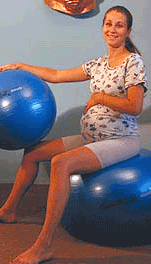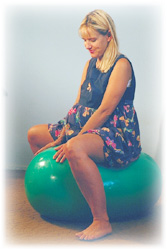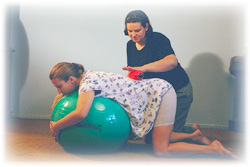


ADOBE in the News
Arizona Foothills Magazine
2006,
PDF article
Arizona Republic Newspaper
2005,
Web
Reprint
![]()
How Birth Balls can contribute to
your pregnancy, birth and postpartum.
Sitting upright on a birth ball or leaning over the ball in the hands and knee position as much as possible the last weeks of pregnancy can help facilitate your baby to drop” or engage into the pelvis in the anterior position.
During your prenatal check-ups, especially in the last trimester, the doctor or midwife will palpate your abdomen to detect the baby's position. While most moms-to-be know that head down is good, few understand the significance of a baby facing the mother’s navel or the mother’s spine.
Occipito-anterior (OA) and Occipito-posterior (OP) often called anterior and posterior for short are the technical terms to describe the way your baby is positioned in the uterus. Both of these terms apply to a baby who is head down.
The best position for your baby to engage into the pelvis is the Occipito-anterior (OA). This is what is called the Optimal Foetal Position (OFP). In the OA position, your baby is head down with his or her face looking at your spine. In the OP position, your baby is head down with his or her face looking at your navel.
Have you ever heard of Back Labor? Have you experienced back labor yourself or do you know someone who has? Back labor occurs because the baby is in the occiptio-posterior (OP) position. An OP baby and mother must do more work in order to have a vaginal birth. Labor is often longer and more painful, while the baby attempts to rotate to the anterior position.
Optimal Foetal Positioning teaches us that simple lifestyle changes like improving your posture can influence the way your baby positions him or herself into the pelvis. Years ago before television women were much more active and when they sat on a couch it was to read or sew. When they were positioned on the couch they sat upright because proper posture was encouraged. Today when we rest on the couch we tend to recline back with our feet up with the remote control in our hands. This is not a good position to be in during late pregnancy because your uterus will contract to try to rotate the baby to the OA position. When the uterus contracts it tilts forward and when we are semi-recumbent we are working against the uterus. This is why women will have frequent long episodes of Braxton-Hicks contractions in late pregnancy because the uterus is trying to rotate the baby to the optimal foetal position.
 Using the Birth Ball for pregnancy and childbirth?
Using the Birth Ball for pregnancy and childbirth?
Sitting upright on the Birth Ball you have to assume proper posture. It is the perfect position to be in as much as possible during late pregnancy. It is recommended that during the last 4 to 6 weeks of pregnancy women sit on the birth ball as much as possible while watching TV, relaxing or at the computer.
-
Sitting upright on the Birth Balls achieves the following:
-
Increases blood flow to the uterus, placenta and baby
-
Relieves pressure and can increase the pelvic outlet as �� much as 30%
-
Provides comfortable support for knees and ankles
-
Provides counter-pressure to the perineum and thighs
-
Mom's can lean forward and pelvic rock, sway and gently �� bounce�
-
Upright posture works with gravity encouraging the �� descent of the baby
Putting all of your upper body weight on the Birth Balls when in the hands and position will do the following:
-
Helps relieve back discomfort and pain
-
Mom's can pelvic rock and reduce tension in the lower back
-
Putting the weight of the upper body on the ball takes the weight off your wrists
-
Encourages rotation of a posterior baby
-
May relieve pressure on swollen anterior lip of cervix
The Birth Ball Supports Women in Laboring Positions
Childbirth Experts and researchers throughout the world have validated that standing, sitting and walking help to shorten labor by 25-40%. When a woman remains upright and active during labor her contractions are stronger, more regular and frequent, which quickens labor progress.
How does an upright position make such a difference in labor?
-
Uterine contractions are more effective in bringing the baby through the pelvis if the mother is upright and can lean forward. A muscle that is required to work against gravity will tire more easily.
-
Pressure from the baby’s head on the cervix remains constant when a woman is positioned upright – so cervical dilation may occur more rapidly.
-
Pelvic mobility is increased during pregnancy by hormones that soften the ligaments in the pelvis. A woman’s pelvic outlet increases as much as 30% when squatting and leaning forward, so the baby may descend more easily during labor and birth. Supported squatting with keeping the knees above the hips offers optimal perineal stretching; less muscular effort; optimal oxygen and blood flow to the baby; and the most effective angle for descent of the baby.
-
Blood flow to the uterus, placenta and infant are more optimal when a woman labors in an upright position. Fetal distress is actually less likely to occur, so the newborn's condition is more stable at birth. When a woman labors in a reclining position, blood flow to the uterus is decreased; oxygen to the uterus and the baby are decreased; and maternal blood pressure increases.
-
When a woman is semi-reclining, the baby’s head puts pressure on the pelvic nerves in the sacrum, increasing pain during contractions. Much less pressure is placed on these nerves if the woman remains upright, leans forward and remains off her back.
-
Gravity enhances uterine contractions and maternal bearing down effort. It is definitely more difficult to push a baby out when a woman is recumbent and essentially pushing uphill.
How can birth balls help childbearing women?
The Birth Ball is a physical therapy ball, usually about 29” in diameter. The ball can be used in prenatal and postpartum fitness programs; used in late pregnancy can help encourage the baby to engage in the OA position; for positioning during childbirth and for comforting the baby after birth.
Using a Birth Ball can make rhythmic movement, changing positions and remaining upright easier. Fatigue is decreased when a woman can rest part of her body on the ball. The ball provides support to hip joints, knees, and ankles so the woman can be mobile for longer periods of time.
STANDING: Gravity helps the fetus to descend during the course of labor. The laboring woman can tolerate standing longer when she rests her upper body on a birth ball that is placed on a bed or stationary chair.
KNEELING: Women often kneel to relieve the pain of back labor and to encourage the rotation of a posterior position baby. Kneeling over the birth ball and rocking or rotating the hips is more comfortable and counter pressure is easier to apply when the woman is in a forward leaning position.
SITTING UPRIGHT: When a woman sits upright on the birth ball she often remarks that her back immediately feels better! She can easily rock back and forth and she finds that the ball provides counter pressure on her perineum and thighs.
POSTPARTUM: After birth women may want to use the birth ball in a postpartum exercise program. A specialist is fitness can assist in obtaining information about a safe exercise program for postpartum recovery.
BABY SOOTHING: Babies love rhythmic movement ad many parents have used the birth ball as an aid to soothing a fussy baby. Some gently bounce on the ball and others move side to side on the ball while holding their baby. The infant craves movement to stimulate his/her nervous system, ad the rhythmic movements on the birth ball can help foster healthy development of the baby.
Sources of information about the physiology of labor:�Active Birth;�Janet Balaskas.�Easing Labor Pain;Adrienne B. Lieberman.�Gentle Birth Choices;�Barbara Harper, RN.�A Good Birth, A Safe Birth;�Diana Korte and Roberta Scaer.�The Birth Partner;�Penny Simkin
